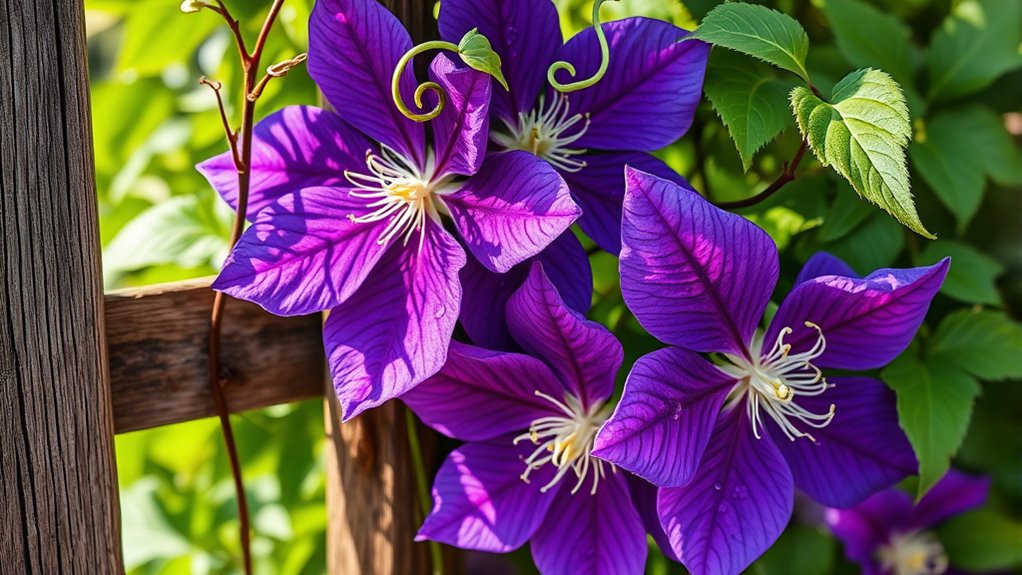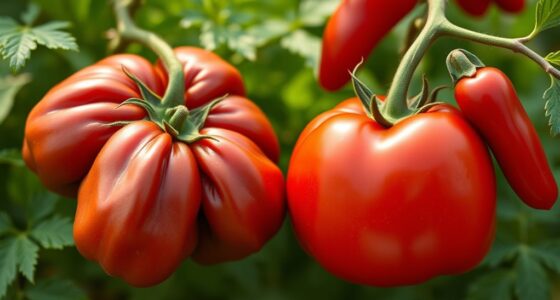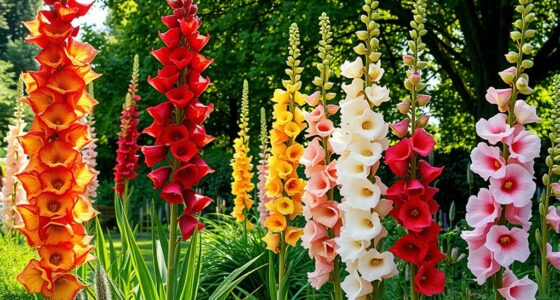Choosing between clematis and honeysuckle depends on your garden’s style, climate, and scent preference. If you want large, star-shaped flowers with subtle fragrance, clematis is a great choice. For vibrant, tubular blooms with a strong, sweet scent, honeysuckle works well. Consider their growth habits, light needs, and space requirements to match your garden design. To find the perfect fit for your outdoor space, learn more about their care and features below.
Key Takeaways
- Consider your climate zone and sunlight exposure to choose a vine suited for your garden conditions.
- Decide if you want a fragrant, long-blooming honeysuckle or a showy, large-flowered clematis.
- Match the vine’s growth habit—sprawling or upright—to your available space and support structures.
- Think about bloom colors and seasons to ensure continuous visual interest and complement your garden palette.
- Assess maintenance needs, such as pruning and watering, to select a vine that fits your gardening routine.
Overview of Clematis and Honeysuckle
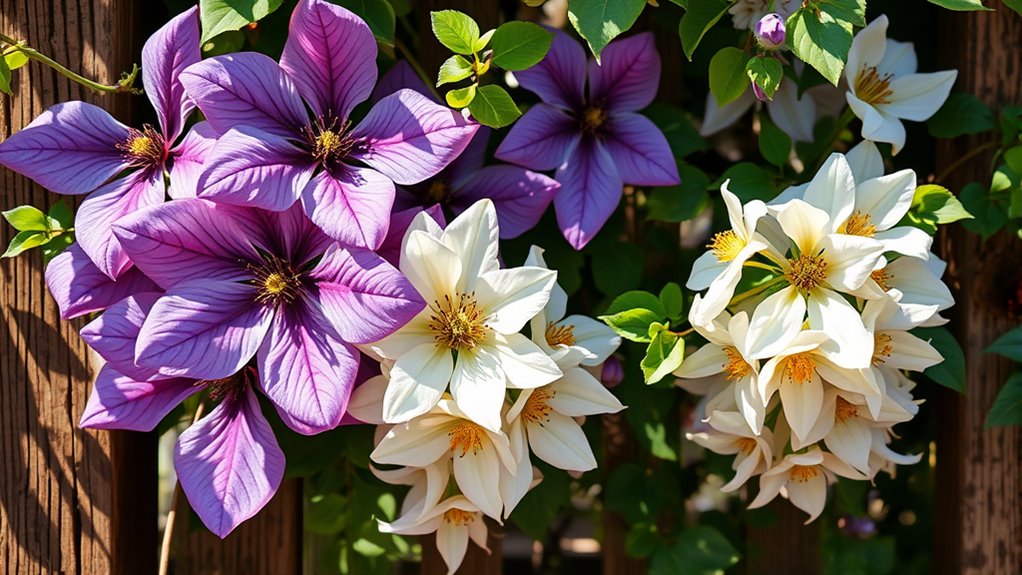
Have you ever wondered what makes Clematis and Honeysuckle popular choices for gardens? These climbing plants add vibrant color and fragrance, enhancing any landscape. Clematis thrives with proper pruning techniques, which vary depending on the variety, ensuring healthy growth and abundant blooms. Honeysuckle, on the other hand, benefits from a consistent fertilization schedule, promoting vigorous flowering and lush foliage. Both require some maintenance, but their care differs slightly. Clematis often needs pruning in late winter or early spring, while Honeysuckle responds well to annual trimming after flowering. Understanding their specific pruning techniques and fertilization schedules helps you keep them healthy and beautiful. Additionally, knowing how to properly support climbing plants can greatly affect their growth and flowering potential. Using appropriate support structures, such as trellises or arbors, provides the necessary stability and encourages upward growth. Proper plant training techniques also contribute to the aesthetic and health of these vines. With proper care, these plants can become stunning focal points in your garden year-round.
Visual Differences in Bloom Appearance
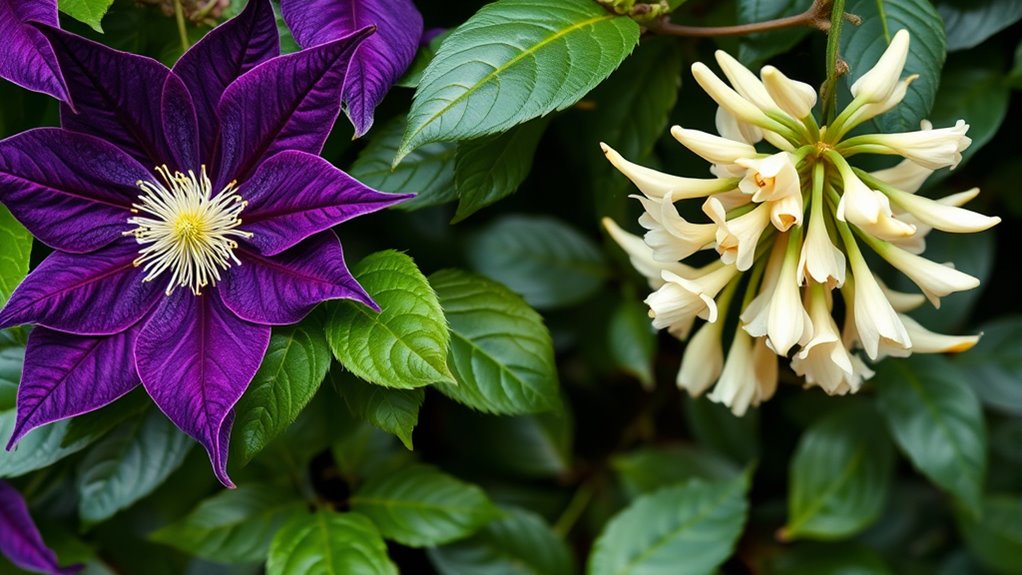
You’ll notice that clematis flowers tend to have a star-shaped or cup-like structure, while honeysuckle blooms are tubular and elongated. Their colors also vary widely, with clematis offering bold hues and honeysuckle often showing softer shades. Additionally, their flowering times differ, so you can identify them by when they bloom throughout the season. Paying attention to flowering characteristics can further help distinguish these vines more accurately. Recognizing plant morphology can also assist in identifying these flowering vines more precisely. Understanding growth habits provides further clues about their development and care needs.
Bloom Shape and Structure
Clematis and honeysuckle display distinct bloom shapes that make them visually easy to distinguish. Clematis typically features large, star-shaped blossoms with a prominent flower cluster, often forming a symmetrical and layered blossom arrangement. In contrast, honeysuckle produces tubular or trumpet-shaped flowers that grow in dense, elongated clusters, giving a more streamlined appearance. The structure of a clematis flower emphasizes wide, flat petals radiating from the center, while honeysuckle’s blossoms tend to be smaller and more tubular, often curling at the edges. These differences in bloom shape and arrangement help you identify each vine easily, especially when viewing multiple flowers together. Recognizing whether you’re looking at a broad, layered blossom or a slender, tubular cluster guides your choice based on your aesthetic preference.
Flower Color Variations
Both clematis and honeysuckle offer a striking variety of flower colors that can enhance your garden’s visual appeal. Their flower color variations showcase a broad spectrum, from vibrant reds and purples to soft pinks and whites. This bloom hue diversity allows you to select a vine that complements your existing garden palette or creates bold contrasts. Clematis typically features cool-toned colors like blues and purples, while honeysuckle often displays warm hues such as yellows, oranges, and reds. The differences in flower color can help you achieve specific aesthetic goals, whether you want a subtle, elegant look or a lively, eye-catching display. Knowing the bloom hue diversity enables you to choose the perfect vine to match your garden’s style and color scheme. Additionally, understanding color variation in flowers can deepen your appreciation for how these vines can complement your outdoor space and create a harmonious environment. Exploring flower color symbolism can also guide you in selecting the ideal vine for your desired mood or theme.
Flowering Season Differences
While clematis and honeysuckle may produce similarly colorful blooms, they differ especially in their flowering season and how their flowers appear during those times. Clematis typically blooms in late spring to early summer, with flowers that often appear on previous year’s growth or new vines, depending on the variety. Honeysuckle, on the other hand, usually blooms from late spring through summer, with a longer bloom timing that can extend into early fall. The visual differences are also clear—clematis flowers tend to be large and showy, while honeysuckle blossoms are smaller, tubular, and often fragrant. Additionally, understanding their flowering season differences can help you plan your garden for continuous color and visual appeal throughout the growing season. Furthermore, knowing the growth habits of each vine can ensure proper pruning and care to maximize their flowering potential.
Fragrance and Scent Profiles
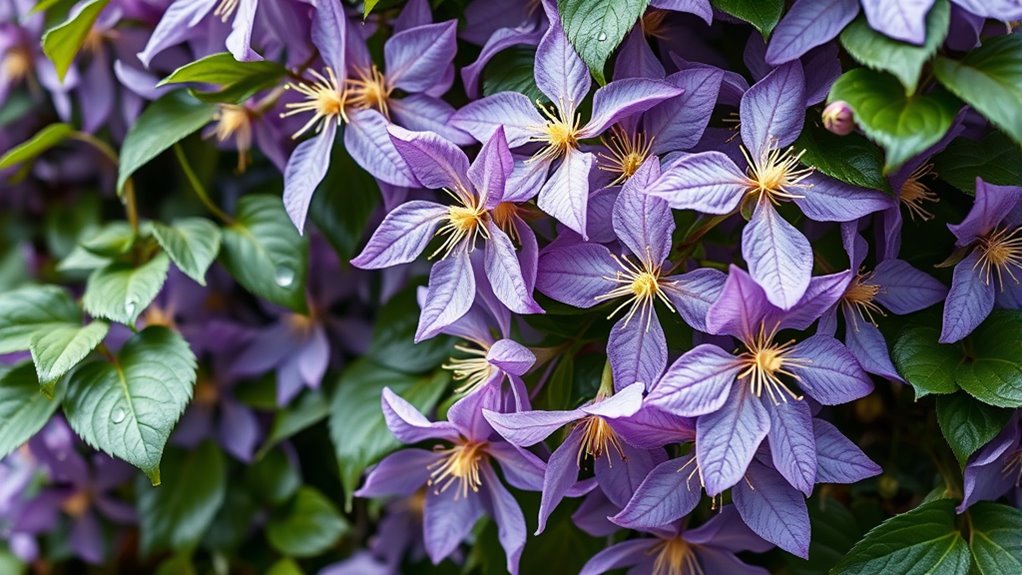
Ever wonder what makes each of these flowering plants so appealing beyond their appearance? The fragrance and scent profiles play a big role in their charm. Honeysuckle is known for its sweet, strong scent that fills the air, with high scent intensity and long-lasting fragrance. Clematis usually has a more subtle aroma, often delicate and fleeting. When choosing, consider how much scent you desire and how long it lasts. Honeysuckle offers bold, persistent aroma, perfect for sensory impact, while clematis provides a gentle, fleeting fragrance. Additionally, essential oils like lavender or eucalyptus can be used to enhance indoor aroma and ambiance. Understanding the aroma strength of each plant can help you select the perfect vine for your garden or indoor space. For example, considering the scent longevity can ensure your garden maintains a pleasant atmosphere over time.
Growth Habits and Climbing Styles
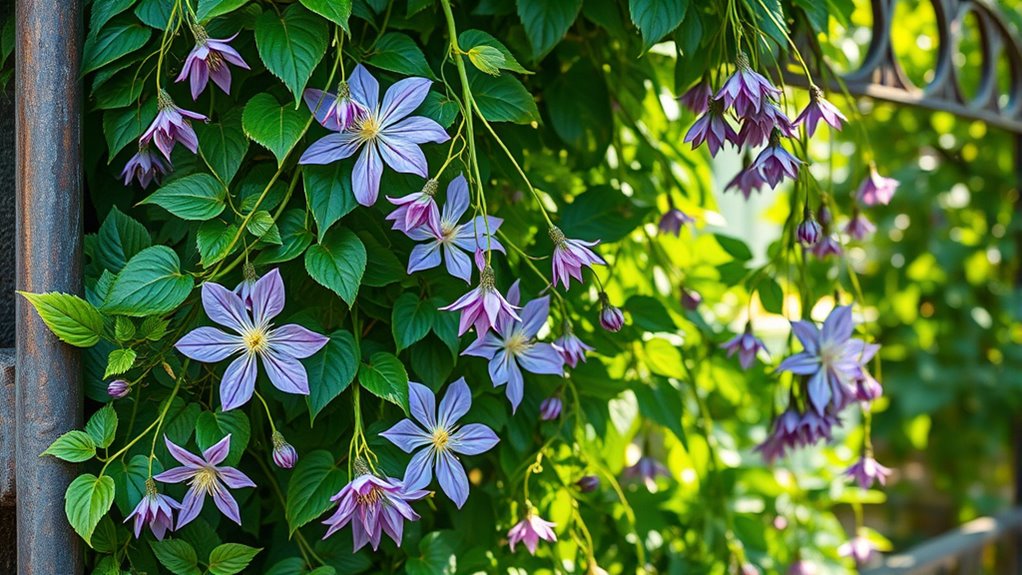
Clematis and honeysuckle exhibit distinct growth habits and climbing styles that influence how you can incorporate them into your garden. Clematis typically has a tall growth habit, climbing by wrapping its tendrils around supports, making it ideal for trellises or arbors. It often features a more refined, upright form, with some varieties reaching impressive heights. Honeysuckle, on the other hand, can display a bushy form or a vigorous, sprawling growth habit. It climbs by twining its stems around supports or spreading out as a dense, bushy vine. If you prefer a more compact, bushy appearance, honeysuckle can fill in space quickly. Understanding these growth patterns helps you choose the right vine for your space, ensuring it grows healthily and complements your garden’s structure. Quotes about growth habits can help inform your planting choices. Additionally, considering the support system you provide can significantly influence how well each vine performs and thrives in your garden.
Light and Soil Preferences
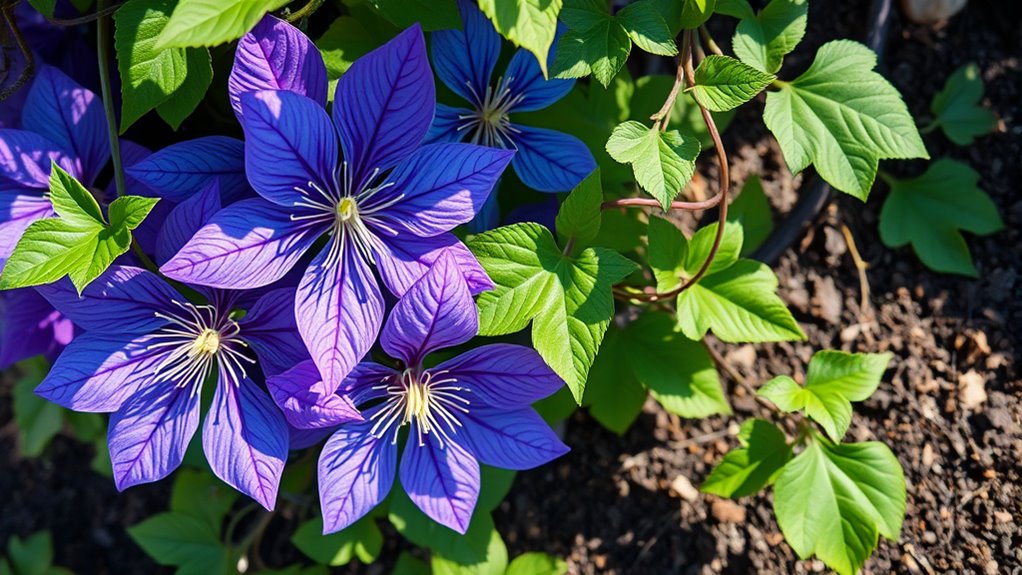
To help your vines thrive, you need to understand their light requirements—some love full sun, while others prefer partial shade. Equally important is choosing the right soil, with well-draining, fertile compositions that support healthy growth. Knowing these preferences guarantees your clematis or honeysuckle will flourish in your garden. Additionally, selecting the appropriate soil type can prevent issues like root rot and promote vigorous flowering. Proper watering techniques, such as using self watering plant pots, can also help maintain consistent moisture levels and improve overall plant health. Regularly monitoring symptoms of poor growth can help you identify and address problems early, ensuring your vines remain healthy and vibrant.
Light Requirements for Vines
Understanding the light needs of your climbing vines is essential for healthy growth. Different vines have varying light requirements, so knowing whether your garden provides full sun, partial shade, or full shade helps you choose the right species. Some vines, like honeysuckle, tolerate more shade and still thrive, thanks to their shade tolerance, while others, like clematis, prefer more sunlight. If you’re dealing with drought-resistant varieties, guarantee they get enough light to maximize their resilience. Keep in mind that improper lighting can lead to weak growth or poor flowering. To help you decide, consider these key points:
- Full sun promotes abundant flowering
- Partial shade suits shade-tolerant vines
- Drought-resistant plants need sufficient light
- Shaded spots may limit flowering potential
- Monitoring soil conditions and moisture is crucial for overall plant health to ensure optimal growth.
Soil Composition Tips
Choosing the right soil composition is essential for your vines to thrive, as both light and soil preferences influence growth and flowering. To support healthy growth, make certain your soil has adequate nutrients by enriching it with compost or organic matter. Both clematis and honeysuckle prefer well-draining soil that retains moisture but doesn’t stay waterlogged. Pay attention to pH balance; most flowering vines thrive in slightly acidic to neutral soil, around pH 6.0 to 7.0. You can test your soil with a kit and amend it as needed. Proper soil composition promotes strong roots, vibrant blooms, and overall vigor. Regularly check soil nutrients and pH levels to maintain favorable conditions, giving your vines the best chance to flourish.
Watering and Maintenance Needs
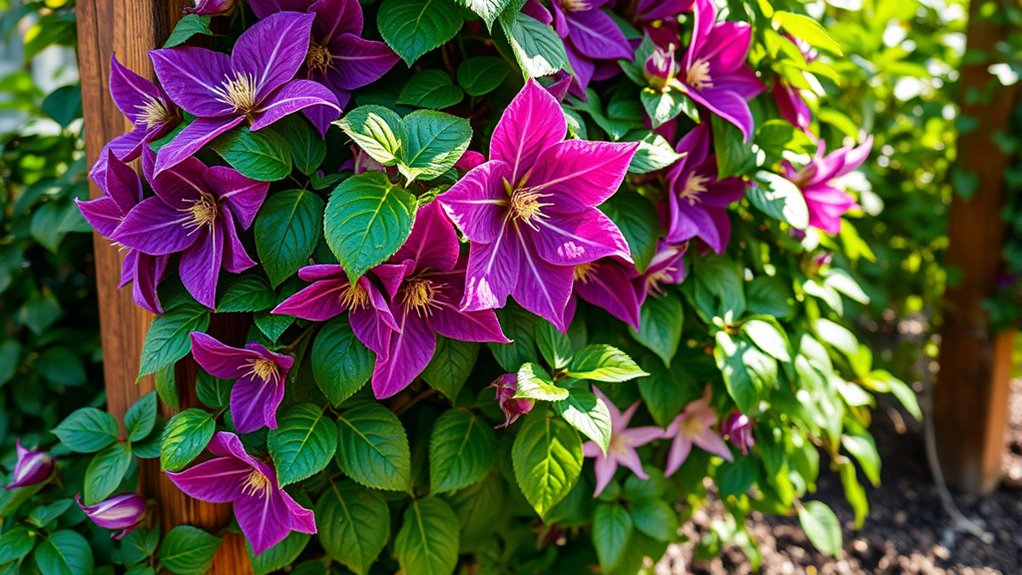
While both clematis and honeysuckle require regular care, their watering and maintenance needs differ slightly. You’ll need to adjust your watering frequency based on the plant’s specific needs and your local climate. Clematis prefers consistently moist soil, so water deeply once or twice a week, especially during dry spells. Honeysuckle is more tolerant but still benefits from regular watering to promote healthy growth. Follow a fertilization schedule tailored to each plant: clematis benefits from a balanced fertilizer in spring, while honeysuckle responds well to a slow-release formula. Keep an eye out for signs of stress, such as wilting or discoloration, and prune as needed to maintain shape and health.
- Water deeply and consistently
- Adjust watering based on weather
- Follow a seasonal fertilization schedule
- Prune to encourage growth
Hardiness Zones and Climate Considerations
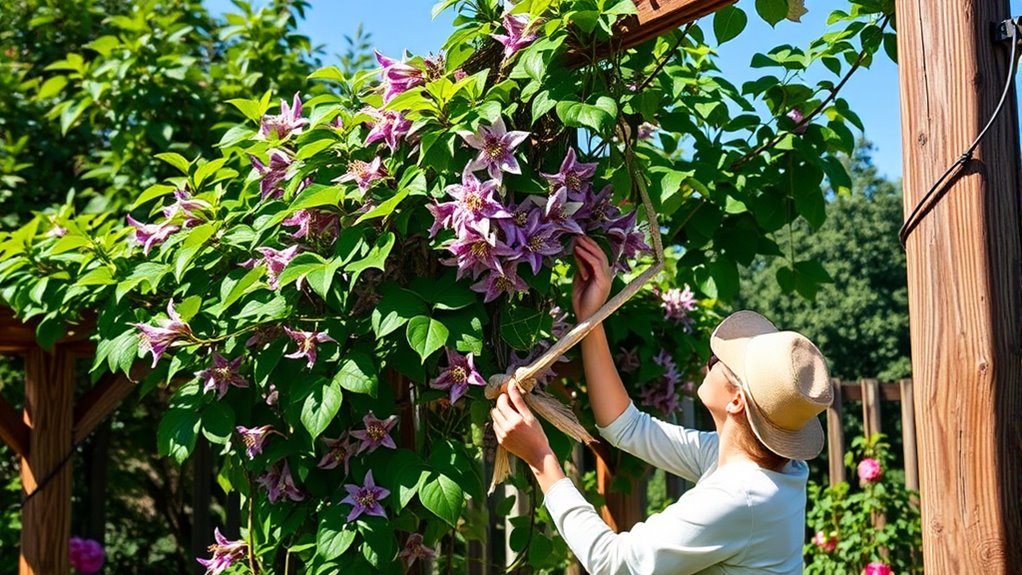
Understanding your plant’s hardiness zone helps guarantee it thrives in your climate. Check zone compatibility guidelines before planting to avoid cold damage or poor growth. Additionally, consider climate adaptation tips to safeguard your plants from extreme weather conditions.
Zone Compatibility Guidelines
Hardiness zones provide essential guidance for selecting plants that can thrive in your climate. Knowing your zone helps you choose vines that will grow healthy and strong, reducing maintenance and ensuring vibrant blooms. When selecting between clematis and honeysuckle, consider their zone compatibility to avoid frustration. For success, pay attention to pruning techniques suited for each vine, as improper pruning can affect flowering. Also, learn about their fertilizer requirements to support healthy growth and abundant flowers.
- Match your zone to the plant’s recommended hardiness range
- Adjust pruning techniques based on vine type and season
- Use appropriate fertilizer for ideal flowering and growth
- Protect plants from microclimate extremes within your zone
Climate Adaptation Tips
Choosing the right vines for your garden depends heavily on your local climate and specific conditions within your hardiness zone. To adapt, consider microclimate adjustments like planting in sheltered spots or using mulch to regulate temperature. These small changes can help your vines thrive despite temperature fluctuations. Additionally, seasonal pruning strategies are essential; pruning at the right time encourages healthy growth and flower production tailored to your climate. For cooler zones, prune later in the season to protect buds, while in warmer areas, early pruning can promote vigorous growth. Understanding your zone’s requirements allows you to make informed decisions, ensuring your clematis or honeysuckle flourish year-round. Proper climate adaptation maximizes your vine’s health and flowering potential.
Support Structures and Space Requirements
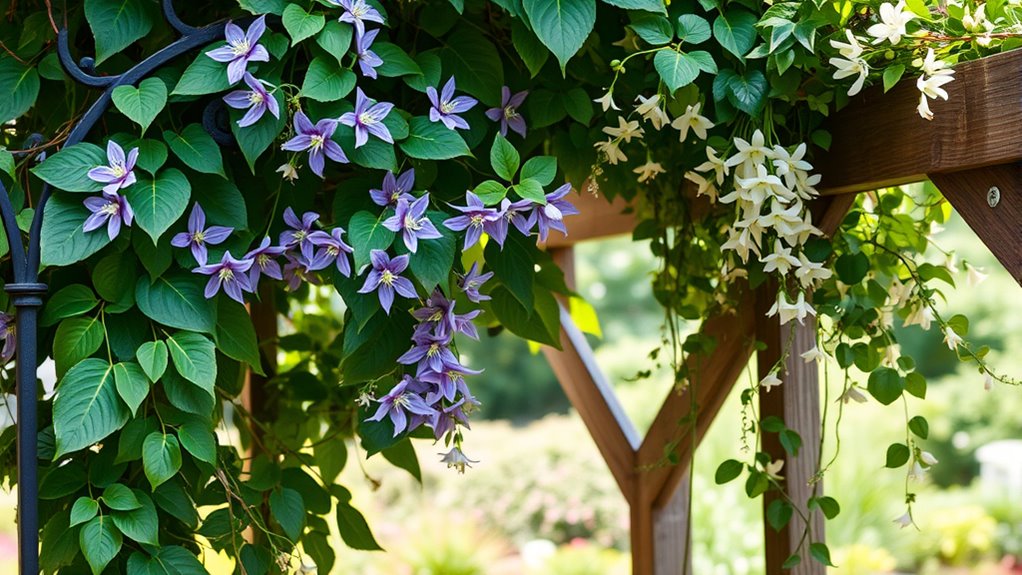
Both clematis and honeysuckle require sturdy support structures to thrive, as they are vigorous climbers that need something to latch onto. Proper support, like a trellis support, helps guide their growth and keeps them healthy. When planning your garden space, consider how much room each vine needs to flourish without overcrowding.
- Choose a durable trellis or arbor that can handle their weight
- Ensure enough space for growth, considering mature size
- Position supports in areas with good sunlight exposure
- Incorporate space planning to prevent overcrowding and promote airflow
Pest and Disease Resistance
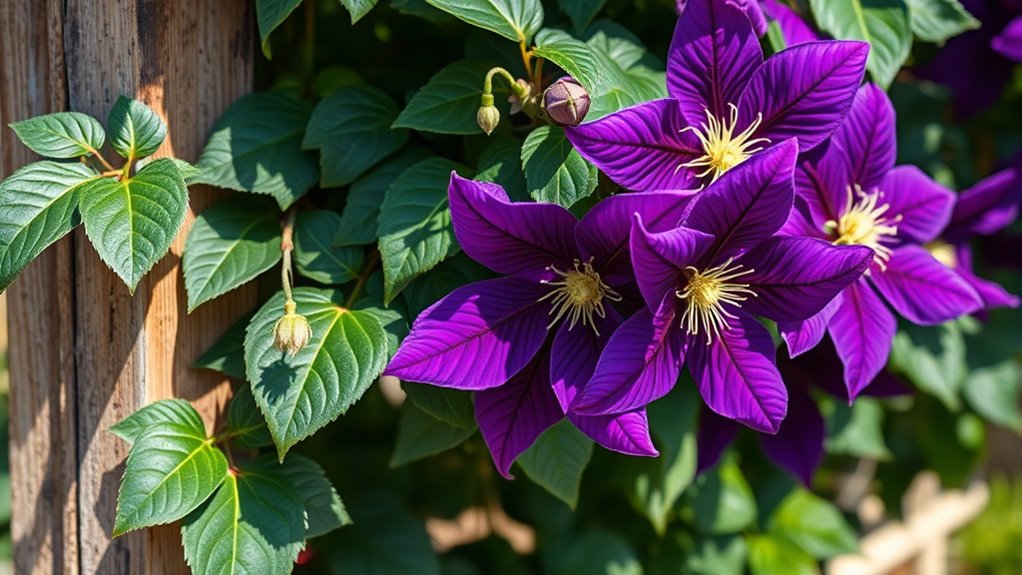
While clematis and honeysuckle generally resist many common pests and diseases, their susceptibility can vary based on growing conditions and maintenance practices. Clematis often shows good pest resistance but can be vulnerable to aphids, slugs, or vine borers if not monitored. Honeysuckle typically resists pests but may attract aphids or scale insects. When it comes to disease susceptibility, clematis can be prone to wilt, powdery mildew, or root rot if overwatered or planted in poorly-drained soil. Honeysuckle is generally hardy but can suffer from fungal issues like leaf spot or powdery mildew in humid conditions. Proper pruning, good airflow, and regular inspections help minimize these risks, ensuring your vines stay healthy and vibrant throughout the season.
Ideal Uses and Placement in the Garden
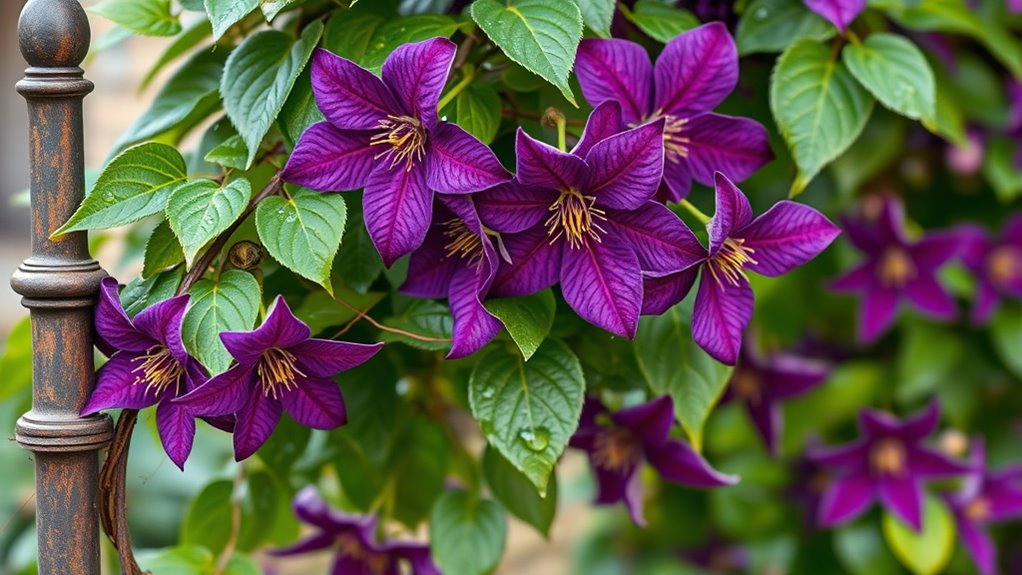
Clematis and honeysuckle offer versatile options for enhancing your garden’s visual appeal, thanks to their vibrant blooms and lush foliage. When planning your garden design, consider their ideal placement to maximize growth and beauty. Clematis works well on trellises, arbors, or fences, adding vertical interest. Honeysuckle is perfect for covering pergolas or walls, creating a fragrant canopy. Use companion planting to pair these vines with shrubs and perennials for a layered display. Keep in mind their light and soil needs to ensure healthy growth. Proper placement not only highlights their features but also encourages flowering. Think about your garden’s overall style and select spots where these vines can thrive while complementing other plants. This approach guarantees a balanced, attractive, and functional garden space.
Frequently Asked Questions
Which Flowering Vine Attracts More Pollinators?
You’re wondering which flowering vine attracts more pollinators. Pollinator preferences vary, but generally, plants with bright, fragrant flowers drawn during their peak flowering season tend to attract more insects like bees and butterflies. To maximize pollination, choose a vine that blooms when pollinators are most active. Both clematis and honeysuckle have their merits, but honeysuckle’s fragrant, tubular flowers often draw more pollinators during its flowering season.
How Do Clematis and Honeysuckle Compare in Drought Tolerance?
Ever wondered which vine withstands dry spells better? Both clematis and honeysuckle have different drought resilience levels. Honeysuckle generally handles droughts more effectively, needing less frequent watering needs to stay healthy. Clematis, however, prefers consistent moisture and may struggle during prolonged dry periods. For a low-maintenance, drought-tolerant option, honeysuckle could be your best choice. Wouldn’t you want a vine that thrives with less water?
Are There Any Common Wildlife Conflicts With These Vines?
You might wonder if these vines cause wildlife conflicts. Both can attract birds for nesting, which is great for local ecosystems. However, honeysuckle’s invasive potential can lead to it overtaking native plants, disrupting wildlife habitats. Clematis generally doesn’t pose such risks. Keep an eye on wildlife nesting habits and avoid planting invasive species, ensuring your garden supports local wildlife while preventing unintended ecological issues.
Can These Vines Be Grown in Containers Successfully?
Imagine a medieval knight tending to a lush garden—now, you can do the same with container gardening. Both clematis and honeysuckle thrive in pots if you use sturdy vine trellises. make sure they get plenty of sun, well-drained soil, and regular watering. With proper support and care, these flowering vines can flourish in containers, transforming your space into a vibrant, living tapestry just like an ancient castle’s courtyard.
What Are the Best Companion Plants for Clematis or Honeysuckle?
You should choose companion plants that complement your flowering vine’s needs. Consider a shade-tolerant flowering shrub like hydrangeas or azaleas to provide contrast and support. These plants thrive in similar conditions and enhance your garden’s aesthetic. Avoid overly aggressive plants that may compete with your vine for nutrients or space. Selecting the right companions creates a balanced, thriving garden that highlights your flowering vine beautifully.
Conclusion
Choosing between clematis and honeysuckle is like selecting a guiding star for your garden’s soul. Each vine offers a unique melody—one’s delicate blooms, the other’s sweet aroma—shaping your outdoor sanctuary. By understanding their symbolism—clarity and passion—you craft a space where beauty and meaning intertwine. Whichever you select, let it be a reflection of your garden’s spirit, illuminating your landscape with timeless elegance and heartfelt charm.
